Guía de práctica clínica para la evaluación y el manejo de la hemorragia digestiva alta en el Seguro Social del Perú (EsSalud)
Related Resource(s)
http://www.scielo.org.pe/scielo.php?pid=S1022-51292018000100015&script=sci_arttext&tlng=enDate
2018-03Author(s)
Vásquez Quiroga, Jorge
Taype Rondan, Álvaro
Zafra Tanaka, Jessica Hanae
Arcana López, Ericson
Cervera Caballero, Luis
Contreras Turin, Javier
Guzmán Cáceres, Katherine
Llatas Perez, Juan
Marin Calderón, Luis
Piscoya, Alejandro
Vargas-Blácido, Daniel
Vásquez-Valverde, Nelly
Timaná-Ruiz, Raúl
Metadata
Show full item recordAlternate title
Clinical practice guideline for the evaluation and management of upper gastrointestinal bleeding for the Peruvian Social Security (EsSalud)
Abstract
Objetivo: Proveer recomendaciones clínicas basadas en evidencia para la evaluación y el manejo de pacientes con hemorragia digestiva alta (HDA) en el seguro social del Perú (EsSalud). Materiales y métodos: Se conformó un grupo elaborador local (GEG-Local) conformado por especialistas en gastroenterología y metodólogos. El GEG-Local formuló 11 preguntas clínicas a ser respondidas por la presente guía de práctica clínica (GPC). Se buscaron y seleccionaron GPC de HDA publicadas a partir del 2012, que respondieran a las preguntas planteadas y obtuvieran un puntaje mayor a 60% en los dominios 1 y 3 del instrumento Appraisal of Guidelines for Research and Evaluation II (AGREE-II). Durante septiembre del 2017 se realizaron búsquedas bibliográficas en Pubmed, para actualizar 9 preguntas clínicas de las GPC preseleccionadas, y para responder 2 preguntas de novo. La calidad de la evidencia fue evaluada usando la metodología Grading of Recommendations Assessment, Development, and Evaluation (GRADE). En reuniones de trabajo periódicas, el GEG-Local revisó la evidencia y formuló las recomendaciones, los puntos de buenas prácticas clínicas y el flujograma de evaluación y manejo, usando la metodología GRADE Finalmente, la GPC fue aprobada con Resolución N° 80-IETSI-ESSALUD-2017. Resultados: La presente GPC abordó 11 preguntas clínicas, divididas en cuatro temas: valoración de riesgo, manejo inicial, manejo de HDA no variceal, y manejo de HDA variceal. En base a dichas preguntas se formularon 10 recomendaciones (7 recomendaciones fuertes y 3 recomendaciones débiles), 24 puntos de buena práctica clínica, y 2 flujogramas. Conclusión: Este artículo es el resumen de la GPC de EsSalud, en la cual se valoró la evidencia científica disponible sobre evaluación y manejo de HDA. Objective: To provide evidence-based clinical recommendations for the evaluation and management of patients with upper gastrointestinal bleeding (UGB) in the Peruvian Social Security (EsSalud). Materials and methods: A local guideline development group (local GDG) was established, including specialists in gastroenterology and methodologists. The local GDG formulated 11 clinical questions to be answered by this clinical practice guide (CPG). We searched and selected CPG of UGB published from 2012, which answered the posed questions and obtained a score higher than 60% in domains 1 and 3 of the Appraisal of Guidelines for Research and Evaluation II (AGREE-II) tool. During September 2017, bibliographic searches were conducted in Pubmed, to update 9 clinical questions of the preselected CPGs, and to answer 2 de novo questions. The quality of the evidence was evaluated using the Grading of Recommendations Assessment, Development, and Evaluation (GRADE) methodology. In periodic work meetings, the local GDG reviewed the evidence and formulated the recommendations, points of good clinical practice and the flowchart of evaluation and management, using the GRADE methodology Lastly, the CPG was approved with Resolución N° 80-IETSI-ESSALUD-2017. Results: This CPG addressed 11 clinical questions, divided into four themes: risk assessment, initial management, management of non-variceal UGB, and management of variceal UGB. Based on these questions, 10 recommendations (7 strong recommendations and 3 weak recommendations), 24 points of good clinical practice, and 2 flow charts were formulated. Conclusion: This article is the summary of the EsSalud’ CPG, where the available scientific evidence on evaluation and management of UGB was evaluated.
Collections
- Artículos científicos [890]






